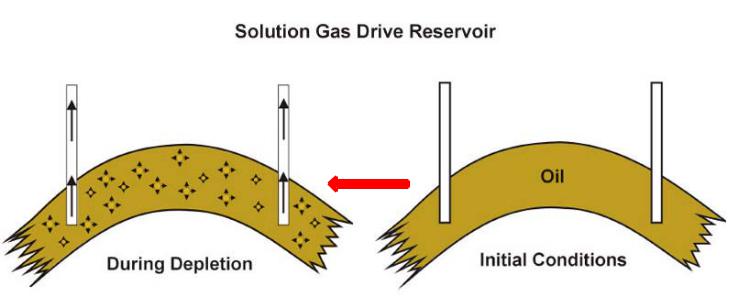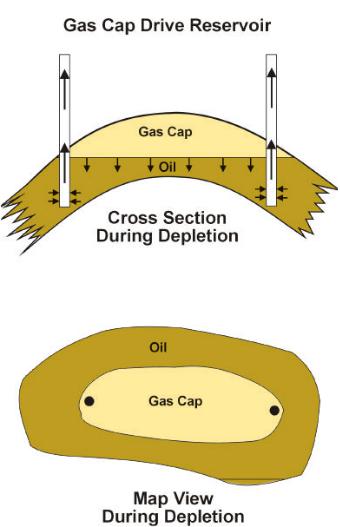
- •COURSE CONTENTS
- •Reservoir Rock Characteristics
- •Porosity
- •Factors Affecting Porosity
- •Total and Effective Porosity
- •Primary and Secondary Porosity
- •Permeability
- •Linear Flow
- •Radial Flow
- •Averaging Permeability (Parallel Sand)
- •Averaging Permeability (Series Sand)
- •Exercise 1
- •Permeability Measurement
- •Slippage Phenomenon during Gas Permeability Measurements
- •Klinkenberg correction
- •Rock and Fluid Interaction
- •Interfacial Tension
- •Wettability
- •Capillary Pressure
- •Relative Permeability
- •STOIIP
- •Exercise 2
- •Type of Reservoir
- •Recovery
- •Drive Mechanism
- •Solution Gas Drive
- •Gas Cap Drive
- •Water Drive
- •Type of Water Drive
- •Gravity Drainage
- •Combination
- •Secondary Recovery
- •Tertiary Recovery (EOR)
- •Thermal EOR
- •Chemical EOR
- •Miscible Gas Flooding
Drive Mechanism
The natural energy of the reservoir used to transport hydrocarbons towards and out of the production wells.
There are five important drive mechanisms (or combinations).
Solution Gas Drive.
Gas Cap Drive.
Water Drive.
Gravity Drainage.
Combination or Mixed Drive
A combination or mixed drive occurs when any of the first three drives operate together or when any of the first three drives operate with the aid of gravity drainage.
Solution Gas Drive
This mechanism (also known as depletion drive) depends on the associated gas of the oil.
The virgin reservoir may be entirely liquid, but will be expected to have gaseous hydrocarbons in solution due to the pressure.
As the reservoir depletes (due to production), the pressure falls below the bubble point, and the gas comes out of solution to form a gas cap at the top. This gas cap pushes down on the liquid helping to maintain pressure.
The exsolution and expansion of the dissolved gases in the oil and water provide most of the reservoirs drive energy.

41

Gas Cap Drive
In reservoirs already having a gas cap (the virgin pressure is already below bubble point), the gas cap expands with the depletion of the reservoir, pushing down on the liquid sections applying extra pressure.
The presence of the expanding gas cap limits the pressure decrease experienced by the reservoir during production.
